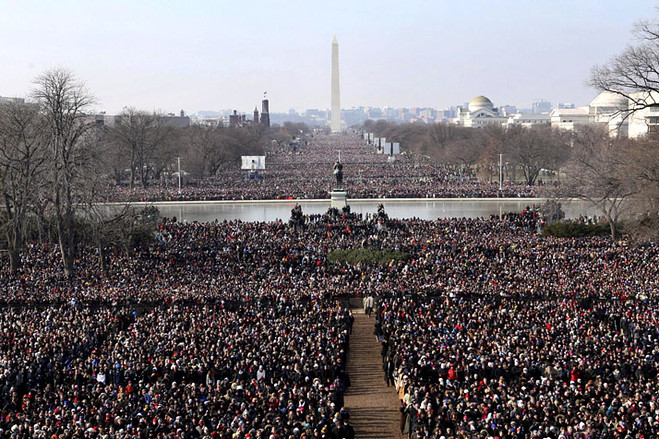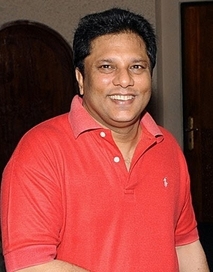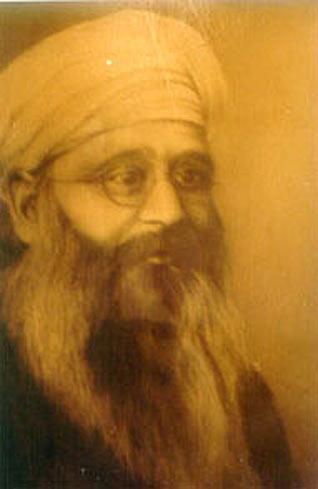
Just when you think that everything is hunky-dory for Sikhs in Canada, you hear of an incident like this that makes your cringe. Here’s a first-hand account of an incident that took place at the Toronto Raptors game last Friday night.
My brother, Gagandeep Singh Saluja and I, Simran Kaur Saluja attended a Raptors game at the Air Canada Centre on the night of Friday, January 30, 2009. I witnessed something which disturbed me tremendously. After a great night of getting two of the Raptors’ players to sign our jerseys and getting Jermaine O’Neal’s wristband, my brother and I make our way out to see the post-game show.
He tells me he has to use the washroom. Entering a public washroom is not unlawful in any way. I witnessed many people entering and exiting the same washroom my brother wished to use. A security guard approached my brother, out of all people as he is a visible minority that stands out. The security guard told my brother to get out. For what reason? Well, let me describe my brother to you all. He is a third-year student studying Business Management at UTSC and a proud Sikh youth who wears his turban with pride and joy…A huge Raptors’ fan as well. Gagan asks him “for what” while he tries to make his way to a stall and the security guard starts pushing him and saying “You don’t want to start with me!” He then calls back-up. Gagan finds himself with 4 to 5 security guards on him trying to kick him out. Police officers get involved during this time and start tackling him.
I sensed something wrong while I was standing outside watching the post-game show. I was hesitant in terms of if I should check on my brother in the washroom but I thought it wouldn’t be appropriate for me to do that. I decided to wait for him as I thought that the security guard had let him use the washroom. I wait for about 10 minutes for my brother…I was getting a bit edgy and started looking around for him. I had not seen anything.
Later, the security guard is out of breath and sweaty and attends to the location where I had seen him prior to the whole washroom catastrophe. I ask him “Aren’t you the one who was in the washroom?” He said “yeah.” He knew that I was there waiting for Gagan and after another 10 minutes he tells me, “You might want to make your way out as to whoever you were with is being arrested.” I race outside to find my brother without his turban on, in pain and suffering. When I saw his face…I don’t know how to explain such regret. I keep thinking to myself ‘had I gone into the washroom?! Maybe, just maybe they would not have used such force against him.’ I love my brother a whole lot and I never want to see him hurt. This whole ordeal that happened in Toronto, Canada out of all places is just sad.
The first week of President Barack Obama’s administration has been important in several respects, perhaps most notably because of the announcements that the Guantanamo Bay facility will close and that the United States, “without exception,” will not torture. While these statements are vitally significant in their own right, they are, in my view, part of a broader theme that the new administration is putting forth — namely, that the United States will regain its position in the world and safeguard its security interests by demonstrating, through action and example, what the nation truly stands for.
This concept, put forth most eloquently by Joseph Nye, Jr., is called “soft power.” It calls for a state to attract others to its causes not just by force or economic coercion, but through attraction. The Obama administration, including newly minted Secretary of State Hillary Clinton, has rebranded this foreign policy strategy, generally naming it “smart power.” (Perhaps the term “soft power” sounds weak and overly accommodating.)
Monday marked notable achievements in the human rights world, for Sikhs affected by the Indian government’s abuses in Punjab in the 80s and 90s, as well as in the arena of international criminal justice.
First, Ensaaf recently partnered with Benetech, a technology organization that has created data analysis software to measure whether documented human rights abuses occurred on a systematic, widespread scale or whether they were arbitrary. On Monday, Ensaaf and Benetech’s Human Rights Data Analysis Group (HRDAG) released their findings.
The report by Ensaaf and HRDAG, Violent Deaths and Enforced Disappearances During the Counterinsurgency in Punjab, India, presents empirical findings suggesting that the intensification of counterinsurgen
cy operations in Punjab in the early 1990s was accompanied by a shift in state violence from targeted lethal human rights violations to systematic enforced disappearances and extrajudicial executions, accompanied by mass “illegal cremations.” Indian security officials have dismissed claims of human rights violations as unavoidable “aberrations” during the counterinsurgency against alleged terrorists in Punjab from 1984 to 1995.
“This report challenges explanations by Indian security forces for enforced disappearances and extrajudicial executions using more than 20,000 records from independent sources which have been analyzed using statistical methods,” said Romesh Silva, a demographer at HRDAG and co-author of the report. “This scientific analysis reveals that answers given by the government regarding the nature and extent of these violations are implausible given the available evidence. The victims and their families have a right to the truth.” [ensaaf]
The press, unsurprisingly, has paid significant attention to Barack Obama’s inauguration. The importance of Obama’s ascendancy to the presidency — in terms of its symbolic and historic significance as well as the substantive policy changes that will follow — cannot be overlooked. Interestingly, the Sikh aspect of Obama-mania also has reached the pages of prominent press outlets. Those reports contain some good news, and even some bad. First, the good….
 Obama gained points when he took the time to provide answers to a questionnaire about Sikh interests and concerns. Indeed, a Harvard professor on religion and the religious diaspora in America, noted: “The Sikhs heard from you too. Your response to the questions… made it clear that you know your Sikh constituents and have a real concern for the issues of discrimination, hate crimes, and profiling they have faced. Your thoughtful response to the Sikhs stood in stark contrast to that of your opponent: ‘No Response.'”
Obama gained points when he took the time to provide answers to a questionnaire about Sikh interests and concerns. Indeed, a Harvard professor on religion and the religious diaspora in America, noted: “The Sikhs heard from you too. Your response to the questions… made it clear that you know your Sikh constituents and have a real concern for the issues of discrimination, hate crimes, and profiling they have faced. Your thoughtful response to the Sikhs stood in stark contrast to that of your opponent: ‘No Response.'”
Also, the Sikh Inaugural Ball — however viewed by some Sikhs themselves (see here and here for our previous coverage) — generally has been favorably seen by non-Sikhs. The Washington Post, for example, profiled a Sikh woman’s journey from California to Washington, DC, to attend the ball. The overarching theme of the piece was how Obama’s election has reinvigorated the Sikh woman’s conception of politics and her place in America. “Now,” she said, “I feel I can call this country my home.” [Aunty Ji, Gulshan Gachoke, is pictured at right.]
The Wall Street Journal, another respected publication, reported from the ball itself. In addition to discussing the details of the ball, the Journal offered this observation: “Several people at the event drew a comparison between Barack Obama and Manmohan Singh, the first Sikh prime minister of India, a country where only 2% of the people identify as Sikh.” (I haven’t drawn this connection in my own mind, but a healthy debate may be had about whether a meaningful link between the two may be made on the basis of their minority status and respective places in the American and Indian governments.)
And now the “bad”….
As the economy’s downturn affects millions of North Americans, you wonder how documented/undocumented immigrants are impacted by it; particularly, when many left friends and families in their home-countries for economic opportunities in the West. Maple Leaf Sikh gave us some insight into how the Punjabi Sikh population is being affected in Canada.
Last week, a KGET news report (view below for video report), focused on the undocumented population in California’s Central Valley. Despite economic hard-times in Kern County, its large undocumented population, who are primarily Latino, has no intention of going back to their home-countries. Regardless of soaring unemployment rates, US economic recession, and a major downturn in California’s construction, service, and agriculture industries, many undocumented workers maintain a tremendous amount of faith in the US economy.
Yesterday, the newly inaugurated president said, “… the world has changed and we must change with it.”
But just what has changed? In the euphoria of yesterday’s ceremonies, some seemed to expect that from now on, the sun would always shine and no one would ever go hungry again. The inaugural ceremony itself provided ample examples of both what had and hadn’t changed.
What ha d changed, at least for a few days in DC was that people were exuberant. Strangers became friends. Hugs, high-fives, and tears were shared with neighbors crowding the national mall, cafes, and homes throughout the city. People were generous. An older woman from California gave her flannel shirt to a younger woman who had been waiting beside her in the bitter cold since 6:30 in the morning.
d changed, at least for a few days in DC was that people were exuberant. Strangers became friends. Hugs, high-fives, and tears were shared with neighbors crowding the national mall, cafes, and homes throughout the city. People were generous. An older woman from California gave her flannel shirt to a younger woman who had been waiting beside her in the bitter cold since 6:30 in the morning.
But in some areas where organization was lacking, the chaos vividly showed that when people’s expectations were unfulfilled, survival of the fittest remained the governing natural law. A Congressman reportedly tried to drive through people waiting in line and got stuck in the crowd when they surrounded his vehicle. At least 4 ambulances were seen transporting people injured by the crushing crowd. These scenes resembled a Delhi train station more than the Washington DC I’m used to.
So, what’s changed?
In Richmond Hill, early Sunday morning, another Sikh youth became a victim of a hate crime. Jasmir Singh’s hair and beard were pulled, and he was stabbed in the eye. He may lose his eyesight. [link]
This past weekend at the Toronto Sikh Retreat a workshop was offered on Guru Tegh Bahadur Ji. I personally think it’s great when we are given the opportunity to delve into the lives of our Gurus. We get to see Sikhi come alive through history. Our Gurus become real as we learn about Sikh principles through their life experiences. No longer are they just pictures on the walls or names to memorize, but perfect humans who overcame personal and communal challenges. Their strong convictions and stead-fast adherence to the values of humility, patience, justice, and equality during difficult times highlights the strength of Sikhi as a practical religion than just a “philosophy”. I hope more conferences and retreats will take this approach.
During the retreat Guru Tegh Bahadur Ji’s life and bani was discussed by participants. As a young boy he was taught by Bhai Buddha Ji and Bhai Gurdas Ji. The former taught him archery and horsemanship, while the latter focused on ancient classics. Thus, Guruji was both a fighter and intellectual that had a deep appreciation for music along with the sword. The Mahima Prakash says: “Sri Tegh Bahadur was the summit of knowledge. He was a recluse at heart, a king in demour. His patience was unmatched, so was his generosity.”
While driving yesterday I heard about an interesting news story on the local conservative talk radio station. Basically, the Mexican father of a 14 year old daughter was arrested by California authorities for selling his 14 year old daughter’s hand in marriage to an 18 year old man. Apparently in Oaxaca (pronounced Wa-ha-ka), a state in Mexico, such practice is normal.
Marcelino de Jesus Martinez, 36, of Greenfield, California, was arrested Monday and booked into the Monterey County Jail, Greenfield police said in a statement. He faces felony charges of receiving money for causing a person to cohabitate, police said.
Martinez had arranged through a third party to have his daughter marry the older teenager, identified by authorities as Margarito de Jesus Galindo, of Gonzales, California. In exchange, Galindo was to pay Martinez $16,000 and provide him with 160 cases of beer, 100 cases of soda, 50 cases of Gatorade, two cases of wine, and six cases of meat, Greenfield Police Chief Joe Grebmeier told CNN.
In the Oaxacan community, such an agreement is “normal and honorable,” he said. “In California, it’s against the law. [Source]
The story is interesting because the novelty of the situation seems to have forced people to actually think about what it means to be a melting pot or an integrated community.?The questions being asked on the?show?I was listening to were the same questions that are asked of Sikh religious practices: Where do we stop being accommodating and begin enforcing laws that protect people? How do we respect culture and enforce laws?
In Sri Lanka last week, a brave voice was silenced. The editor of the Sunday L eader, Lasantha Wickramatunga, was killed by gunmen on two motorcycles on his way to work. With prescience, he had predicted his impending death, believing that he would be killed by the government. He wrote an incredibly moving essay, with instructions that it be published upon his death.
eader, Lasantha Wickramatunga, was killed by gunmen on two motorcycles on his way to work. With prescience, he had predicted his impending death, believing that he would be killed by the government. He wrote an incredibly moving essay, with instructions that it be published upon his death.
A brief summary of the context, the war which Wickramatunga covered and was silenced by, can be found here.
Wickramatunga’s essay is deeply moving. You can find it in full here and here. Below is an excerpt:
No other profession calls on its practitioners to lay down their lives for their art save the armed forces and, in Sri Lanka, journalism. In the course of the past few years, the independent media have increasingly come under attack. Electronic and print-media institutions have been burnt, bombed, sealed and coerced. Countless journalists have been harassed, threatened and killed. It has been my honour to belong to all those categories and now especially the last.
I have been in the business of journalism a good long time. Indeed, 2009 will be The Sunday Leader’s 15th year. Many things have changed in Sri Lanka during that time, and it does not need me to tell you that the greater part of that change has been for the worse. We find ourselves in the midst of a civil war ruthlessly prosecuted by protagonists whose bloodlust knows no bounds. Terror, whether perpetrated by terrorists or the state, has become the order of the day. Indeed, murder has become the primary tool whereby the state seeks to control the organs of liberty. Today it is the journalists, tomorrow it will be the judges. For neither group have the risks ever been higher or the stakes lower.
Why then do we do it? I often wonder that. After all, I too am a husband, and the father of three wonderful children. I too have responsibilities and obligations that transcend my profession, be it the law or journalism. Is it worth the risk? Many people tell me it is not. Friends tell me to revert to the bar, and goodness knows it offers a better and safer livelihood. Others, including political leaders on both sides, have at various times sought to induce me to take to politics, going so far as to offer me ministries of my choice. Diplomats, recognising the risk journalists face in Sri Lanka, have offered me safe passage and the right of residence in their countries. Whatever else I may have been stuck for, I have not been stuck for choice.
But there is a calling that is yet above high office, fame, lucre and security. It is the call of conscience.
 In 2006, Kawaljeet Tagore was fired for refusing to remove her kirpan. This month, she has filed a lawsuit, along with the Sikh Coalition and Becket Fund, against the IRS.
In 2006, Kawaljeet Tagore was fired for refusing to remove her kirpan. This month, she has filed a lawsuit, along with the Sikh Coalition and Becket Fund, against the IRS.
Kawaljeet Tagore, a Sikh American, sued the Internal Revenue Service (IRS) in Houston federal court on Jan. 6 claiming the IRS discriminated against her by prohibiting her from wearing a kirpan, a mandatory article of faith, on her job as a revenue agent at the Mickey Leland Federal Building in downtown Houston. [link]
The case is significant for a few reasons, but this is the first time someone has litigated the right to wear the kirpan specifically in a work-context. There have been other incidents (and sometimes cases) in which a Sikh’s right to wear the kirpan in an educational setting or in a vehicle or place of public accommodation has been disputed and resolved.
As Lohiri season approaches us, the issue of gender equity was once again resurfaces. Some families will celebrate Lohiri for their daughters to show there is no difference, while others will keep it as a boy tradition. I think we should also reflect on the fact gender equity isn’t just solved by equal celebrations when from the beginning we don’t even allow daughters to be born. How many celebrations will “make-up” for the gross in-balance between the male-female ratio in our community?
The issue of female feticide in the South Asian community is an infamous issue. We have heard about the studies in India, Punjab’s high ranking, and the SGPC’s desire to raise unwanted daughters. The common source cited for killing female children is abortion- just never letting them be born. However, the issue is also prevalent in the South Asian Diaspora in America. According to The Mercury News, Indian families are 58 percent more likely to have a son after having three daughters, compared to the natural 51 percent chance.
Lakh Lakh Vaidhayan!
On behalf of the TLH family, I’d like to wish all our readers the very best for 2009.

“Devotees throng the fog-covered holy Sikh shrine of Golden Temple in the northern
Indian city of Amritsar to offer prayers for the New Year January 1, 2009.” [Link]
 The digitization of books has created a whole new way for Sikhs to access their history. I’ve stumbled onto a lot of historical Sikh literature that I had never heard of. For example, through Google’s Book Search function, I discovered a tourist guide to Punjab from the 1880’s (here’s an excerpt on visiting Amritsar).
The digitization of books has created a whole new way for Sikhs to access their history. I’ve stumbled onto a lot of historical Sikh literature that I had never heard of. For example, through Google’s Book Search function, I discovered a tourist guide to Punjab from the 1880’s (here’s an excerpt on visiting Amritsar).
Over the holidays, I found a scanned version of a first edition of The Life and Teachings of Sri Guru Tegh Bahadur. It was written by Puran Singh and published by The Khalsa Agency in Amritsar in 1908. Puran Singh has a way with words like no other Sikh author I’ve ever encountered. His books The Spirit Born People and The Ten Masters are essential readings for anyone interested in Sikhi. In his book on Guru Tegh Bahadur he writes:
He looks upon the world with that far-seeing vacant eye with which a mariner, having lost his boat, looks upon the broad sea, seated on a rock in the middle dashed by the waves of the angry sea. The world to him is lost in the constant vision of the higher Reality of its soul. There is an intense spirit beating within his heart, which weeps ard cries at the sight of a man who is lost in the tempest of passions and remembers not the glorious life of his beyond this little life and the glorious inheritence of his in ideals of God, Love, and Truth.
He is a high abstraction in the love of God, and whenever a single thought of the world lowers his consciousness from those ethereal heights, he at once sings of God-consciousness and soars again.”Remember thy God, remember thy Lord, this is thy one duty, thy only duty,” says he.
However, what I really want to share is his opening introduction. The words are 100 years old, but just as or probably more relevant today.
Although other bloggers have touched upon different aspect of Christmas and the holiday season, while viewing Sepia Mutiny I saw an interesting video of the NORAD-tracked Santa at the Taj Mahal.
However, at the end of the video (cue to :24), I couldn’t help but notice a very familiar Sikh site. Heading north through Punjab, it seems that the NORAD tracking has Santa flying through the Darbar Sahib complex. While they never show Harmandir Sahib (incorrectly called the Golden Temple), they do show Santa flying by the the Langar Hall, passing next to the Ramgharia Bunga, above the Langar Deori, making a quick right that allows us a great view of the Ghanta Ghar Deori, and in the distance the Akal Takht and kesri Nishan Sahib.

Have a wonderful weekend!
I. Introduction
My last post, which addressed the First Global Sikh Civil Rights Conference held by the non-profit group United Sikhs, generated significant discussion. In an attempt to re-focus and reinvigorate that discussion, I wish to first clarify what the post was not about — it was not intended to serve as an indictment of the United Sikhs’ work overall, to criticize specific projects or initiatives other than the conference, or to compare their efforts to that of other Sikh organizations with greater financial resources. Some of the comments did touch on these subjects, though this was not my intention.
My sole interest was and remains the manner in which the United Sikhs decided, on its own, to describe the conference and the report to the public, including necessarily the Sikh members of it. I wrote that it was “the United Sikhs’ characterizations of the conference and report” that I found problematic. Regrettably, the comments to my post — some made spiritedly by United Sikhs Director Mejindarpaul Kaur and others working for or affiliated with the United Sikhs — have done little to assuage my earlier concerns.

Today many Sikhs in Southern California will celebrate Guru Gobind Singh Ji’s Gurpurb. When I think of Guru Gobind Singh Ji, the first thing that comes to mind is the creation of the Khalsa as an army of the pure.
This past summer I was sitting in a group-discussion, with fellow 2nd generation Sikhs (amritdhari and non-amritdhari) in the West, where we were asked to share the first thoughts that came to mind when we thought of the term “Khalsa”. Here are some:
masculine, extremists, ego, amrit, air india bombings, khalistan, rules, khandha/militaristic, collective brotherhood, fiercely independent, love, panj pyare, historical of the past & raj karega khalsa
For myself, I thought it was interesting to see how the media (i.e. newspaper articles, calendars, and television) along with the politicalization of religion and translation of Sikhi between generations is influencing our perceptions of the Khalsa.
What are your thoughts? What do you think they reflect about the state of the Khalsa?
Hope all of you are enjoying your holidays with family and friends! Here is a “Punjabi” take on a Christmas and one of its infamous songs from my favorite British Comedy Show …. “Goodness Gracious Me”!
Some of you may have already seen it (GGM aired long ago, but is available on DVD-sets) … hope you have a great laugh after watching it!

 I saw this article?on BBC online and thought I’d share it with your guys. Basically, the BBC did a composite of six interviews with people of non-Christian faiths and asked them how they spend the time they have off for Christmas.
I saw this article?on BBC online and thought I’d share it with your guys. Basically, the BBC did a composite of six interviews with people of non-Christian faiths and asked them how they spend the time they have off for Christmas.
The Sikh interviewee noted that during this time of year, Sikhs mark the martyrdom of the Sahibzadey and that it is important to remember the significance of our holidays. Agreed.
Last year Anandica wrote a post about Santa Singh and the Khalsa Tree and explained how some families have incorporated Western traditions into Sikhi, to give new meaning to common symbols, but what about Sikhs participating in the religious celebrations of others?
During this holiday season of hard times, not even houses of God have been spared. Some lenders believe more churches than ever have fallen behind on loans or defaulted this year. Some churches, and at least one company that specialized in church lending, have filed for bankruptcy. Church giving is down as much as 15% in some places, pastors and lenders report.
An article in today’s Wall Street Journal highlights the financial pressures being faced by many churches across America. From my perspective, there’s two implications for Sikhs here, one a threat and the other an opportunity.
“There have been too many churches with a ‘build it and they will come’ attitude,” says N. Michael Tangen, executive vice president at American Investors Group Inc., a church lender in Minnetonka, Minn. “They had glory in their eyes that wasn’t backed up with adequate business plans and cash flow.”
I like to spend winter catching up on all the reading I’ve left by the wayside, but imagine my surprise when I came across these op-eds. The first argues that the Sikh youth slate (an all amritdhari slate) that won in Surrey is “fundamentalist,” while the other article argues that Sehajdari Sikhs are, by definition, not Sikhs at all.
Both of these op-eds are a little insane to me. The first argues that the Surrey gurdwara’s prior practice of allowing uncovered heads, shoes, and tables/chairs in the langar hall somehow constituted a “moderated” practice of Sikhi, and it effectively calls for a stand against the amritdhari youth slate, which it maligns as fundamentalist, orthodox, rigid, etc. The second article argues that there is no room in Sikhi for Sehajdari individuals, and then proceeds to trace the history of in/exclusion of non-kesdari Sikhs in SGPC elections.
